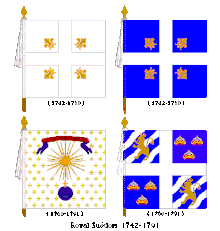Royal Swedish Regiment (France)
The Régiment de Royal Suédois (English: Royal Swedish Regiment) was a foreign infantry regiment in the Royal French Army during the Ancien Régime. It was created in 1690 from Swedish prisoners taken during the Battle of Fleurus. The regiment eventually acquired the privilege of being called a Royal regiment.

German regiment
The regiment nominally accepted only Swedish officers. However most of the privates and NCOs were of German origin, from Swedish Pomerania, in view of the difficulty of obtaining sufficient numbers of Swedish recruits,[1] and at least one Irishman, Daniel Charles, Count O'Connell, was a Lieutenant-Colonel in the regiment.
The actual Swedish element in the regiment diminished after 1740. Between 1741 and 1749 only one of the 438 men enlisted was actually Swedish. By 1754 even the officer corps numbered only 14 Swedes out of a total of 41.[2] In spite of its origins and connections the Royal-Suedois came to be ranked as a German regiment.[3]
Count Axel von Fersen purchased the position of colonel-proprietor of the regiment in 1783, according to some in order to be able to stay close to the Queen of France Marie Antoinette. He remained in active command of the regiment until the beginning of the French Revolution in 1789, and officially this was still the case when, in 1791, all non-Swiss foreign regiments of the royal army lost their traditional titles and status. The regiment was then reorganised as the new 89th Regiment of the Line.[4]
Regimental title
Initially named the Lenck Regiment, the unit was renamed as the Appelgrehn Regiment in 1734. These titles were both names of the successive regimental colonels, following the usual French Army practice of the period. However in 1742 the Swedish government requested that the regiment be given the distinction of being renamed Royal-Suedois.[5]
Colours
- King’s Colours and Regimental Colours
 King’s Colour 1690 to 1760
King’s Colour 1690 to 1760 régiment de Leisler 1690 to 1694
régiment de Leisler 1690 to 1694 régiment de Sparre 1694 to 1714
régiment de Sparre 1694 to 1714 régiment de Lenck 1714 to 1734
régiment de Lenck 1714 to 1734
 régiment d’Appelgrehn 1734 to 1742
régiment d’Appelgrehn 1734 to 1742 King’s Colour 1760 to 1790
King’s Colour 1760 to 1790 régiment Royal-Suédois 1742 to 1760
régiment Royal-Suédois 1742 to 1760 régiment Royal-Suédois 1760 to 1790
régiment Royal-Suédois 1760 to 1790
Uniforms
From about 1750 onwards the regiment was distinguished by wearing dark blue coats with buff (yellow-brown) collars and cuffs.[6] This colour combination matched the uniform of most infantry regiments in the Swedish Army from the 17th to the early 20th centuries.
- Uniforms
 Johan Cronhielm in the uniform of régiment, Lenck, ca 1730
Johan Cronhielm in the uniform of régiment, Lenck, ca 1730 régiment Lenck, 1729 to 1734
régiment Lenck, 1729 to 1734 regiment Appelgrehn, 1734 to 1742
regiment Appelgrehn, 1734 to 1742 Grenadier of régiment Royal-Suédois, 1762 to 1776
Grenadier of régiment Royal-Suédois, 1762 to 1776Montigny_Claude-Antoine_bpt6k15213965_213.jpg.webp) régiment Royal-Suédois in 1772
régiment Royal-Suédois in 1772 régiment Royal-Suédois, from 1776
régiment Royal-Suédois, from 1776
Swedish regiment
In December 1813, the regiment was once again raised by a French émigré in Germany, and it fought in the Swedish Army during the Battle of Leipzig in 1813 and during the campaign in Norway in 1814. The Royal Suédois was finally disbanded in December 1814 while in Norway.
Traditions
Today, the regiment's traditions and flag are carried on in the French Army via a company in the 4th Infantry Regiment.
References
- Christopher J. Tozzi, page 21 "Nationalizing France's Army. Foreign, Black and Jewish Troops in the French Military, 1715-1831, ISBN 978-0-8139-3833-2
- Christopher J. Tozzi, page 236 "Nationalizing France's Army. Foreign, Black and Jewish Troops in the French Military, 1715-1831, ISBN 978-0-8139-3833-2
- Christopher J. Tozzi, page 21 "Nationalizing France's Army. Foreign, Black and Jewish Troops in the French Military, 1715-1831, ISBN 978-0-8139-3833-2
- Crowdy, Terry. French Revolutionary Infantry 1789-1802. p. 12. ISBN 1-84176-660-7.
- Christopher J. Tozzi, page 236 "Nationalizing France's Army. Foreign, Black and Jewish Troops in the French Military, 1715-1831, ISBN 978-0-8139-3833-2
- Funcken, Liliane et Fred. L'Uniforme et les Armes des Soldats de la Guerre en Dentelle 1. pp. 64–65. ISBN 2-203-14315-0.
- Beckman, Margareta. Under fransk fana!: Royal Suédois. Stockholm: Svenskt Militärhistoriskt Bibliotek, 1995. ISBN 91-972209-1-4